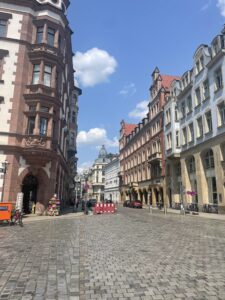I feel very priveliged to have had the opportunity to perform in our final concert in the Alte Börse, the Old Stock Exchange, Leipzig’s oldest baroque building. In the concert, I played in several ensemble Bach pieces including Contrapunctus No.5 from Die Kunst der Fuge (alongside Vito, Maurice, and Tendekai), “Vivace” from Konzert für zwie Violinen (alongside Noah), and of course our two cantatas — “Jesus bleibet meine Freunde” from BWV 147 and “O große Lieb” from Johannes-Passion. I also had the wonderful opportunity to play “Andante” from Clara Schumann’s Piano Trio!
It was really fun to play the Bach double alongside Noah. It is a piece I have had in my repertoire for many years, but haven’t had the opportunity to perform. It was enjoyable to come back to the piece and focus on our interpretative choices, both already comfortable with the notes: when preparing, we practiced in several different tempos, having listened to different interpretations of the pieces. We also worked on pencilling in dynamic markings, including sections that would be softer or more assertive — but what was nice was that in the concert, we ended up listening to each other so carefully that our interpretation felt relatively spontaneous!
I also had a lot of playing Clara Schumann’s Piano Trio – she is a composer I have long admired but up until this point had never played. In our rehearsals, Ruth, James, and I worked on coming together as an ensemble, listening to each other, and matching each others’ sound. In my own practice, I worked on bow distribution (in order to make as rich a sound as possible), and on my tuning and rubato in the solo sections. I thought it came together nicely in the concert, as we were all listening to each other appropriately and had a balanced, rich sound. As we played, I thought about Clara Schumann’s own embellished performances and tried to channel her playing (shoutout to the Goethe House in Weimar, where I learnt that Clara Schumann used to perform for Goethe!).
The piece I had initially felt most challenged by was The Art of the Fugue. When we had initially read through, the piece hadn’t always felt like it was coming together (tempo, balance, and style-wise). I was also a little daunted by leading the ending section. After listening to the piece a few times, following along with the score, I felt more comfortable with the tempo, and started listening more to the others, which helped massively with our balance. In our rehearsals, we talked a lot about our interpretive choices, discussing vibrato and balance. In the end, we settled on including some vibrato, but not too much, and as we practiced, we gradually became better at listening to each other and understanding the balance! In the end, despite a few hiccups, we performed pretty successfully, listening to each other and making sure that we were matching each others’ sound and tempo.
It was also fun to work on the ensemble pieces. I don’t have a lot of experience working with singers, so it was fun to work on balance. I especially enjoyed “Jesu bleibet meine Freunde.”
Also, it was fun to perform my solo on Tuesday! Even though playing in a concert is never as good as in individual practice, it was nice to play some solo violin Bach in the city in which he himself lived, and share what I have been practicing with others. It also gave me a nice opportunity to get back into practicing solo works even though I hadn’t taken solo lessons over the past year.
In all, this concert was a fabulous experience, and has inspired me to keep practicing and expanding as a musician over the Summer and into next year!
Author: Charlotte Defriez
The annotations, edits, and markings made by musicians on some of Bach’s original manuscripts were what stood out to me the most during our first visit to the Bach archive . It was fascinating to see how Bach’s performance ideas shifted and evolved throughout the course of his life as his works were performed, and how some of his ideas were recycled in different pieces or edited to fit a different piece’s requirements. I felt incredibly privileged by the opportunity to see some of the original scores (penned by his copyists) and the account books that included his signature. I also enjoyed our later visit to the Bach VR exhibit, which highlighted an increase in accessibility beyond the scholarly realm to Bach’s life and works – I found his use of the snuff box amusing, his anecdotes about his childhood and life entertaining, but was a little unsettled by the idea that Bach was supposed to be talking to me…
Of particular interest to me during our primary visit was the cartoonish satire doodle in one of the choristers’ chorale books:

First, I think this scribble humanizes Bach’s choristers. It is easy to forget, as we discussed repeatedly during our time in Leipzig, that those we consider ‘greats’ were human too, and faced the same human interactions and emotions that we have today. It also uncovers a rare moment of humor, reminding me of the long history of political satire. Clearly, the rehearsals and work of the Thomanerchor cannot always have been as serious as I imagine them – was the chorister bored? Or perhaps sneaky? Or did he take the book back to his lodgings with him? It is fun to imagine the possibilities about how this image came about.
The doodle itself is indicative of a mindset of ridicule toward the Leipzig guards who paroled the city walls, hinting at an attitude of mockery on the part of the chorister in question. Perhaps this chorister thought that the guards were useless – after all, they are depicted as rats – or otherwise invasive and unnecessary. The rats look almost unable to use their large weapons, which stand much taller than them, suggesting that they are unable to do their jobs. Moreover, their heads are pointed upwards, making them look oblivious of their real responsibilities. All this indicates to me an attitude of mockery, distrust, and ridicule of the military presence in Leipzig from the chorister — perhaps he considered Leipzig’s defenses insufficient, or perhaps this is a criticism of the necessity of guards (is the music contained in the chorale book perhaps the antithesis to the militance or inefficiency of the guards in Leipzig?)… What can we take away more broadly from this image beyond the chorister’s own musings?
Peter Wollny noted that as of yet they had not been able to decipher the text around the doodle, and at that point in the course, my German was not good enough to attempt to figure it out myself. It would be fascinating to me to further uncover what was meant by this cartoon with the words that surround it!
“It feels so weird to clap in a Church,” I whispered to Ruth as we stood clapping for the singers who had just finished performing the “Art of Dying” cantatas. It was a new, strange, and somewhat jarring feeling for me, having grown up playing violin for a Church choir, taught to never clap or expect applause with Church music, to give standing ovations to orchestral performers and singers in both the Nikolaikirche and Thomaskirche.
Throughout this course, I was prompted to reflect on the fascinating multifaceted roles of European Churches.
First, the sites of the Churches we visited are extremely historically significant, which immensely enhanced my visits and appreciation for our concert venues. It is amazing that the Thomaskirche, for example, was visited and even frequented by figures the likes of Luther, Bach, Mozart, and Wagner. And the Nikolaikirche was renowned philosopher Leibniz’s birthplace! More recently, the Nikolaikirche was the site of the “Monday Demonstrations” that were part of the 1989 ‘Peaceful Revolution,’ mobilizing 70,000 people to walk the streets of Leipzig on the GDR’s fortieth anniversary in one of the most significant political uprisings preceding the fall of the Soviet Union. All this to say — it is incredible how much you learn and retain from a few Church panels (and a visit to the Zeitgeschichteliches Forum) – and incredible to be able to listen to concerts in these historically significant buildings!
Next, the Churches stand as symbols of riveting debate around religion, secularism, and pluralism. For instance, in the thirteenth century, the site where the Thomaskirche now stands was home to an Augustinian Monastery. That the Thomaskirche went from Catholic to Lutheran in a matter of a few centuries is fascinating — it was also cool to really be able to appreciate the importance of the religious reformation which was taught repeatedly during my high school years (also, shoutout to the Stadtgeschichtliches Museum). It made me think about how important it is to consider religious pluralism and inclusion on a larger historical scale. On a similar note, I was fascinated to learn upon my visit to the Frauenkirche in Weimar that the Church was only fully rebuilt in 2004, almost fifteen years after the fall of the Berlin Wall. Even though the Thomaskirche and the Nikolaikirche were kept in shape during the GDR years (perhaps to attract Western tourism), the Frauenkirche, facing the same fate as many religious institutions under the rule of the USSR, was left in ruins. It was not rebuilt until the eventual reunification of Germany. Even then, it had to encourage a huge fundraising campaign in order to raise sufficient funds. Its basement space included an exhibition, some ruins, and a space to reflect on the role of religious spaces in the modern age.
Finally, I found it interesting to think more about the ethics of tourism in Churches. Is it appropriate to charge people to visit religious spaces? What are the ethics of performing concerts in Churches, out of their intended religious context? What role should tourism play in these spaces?
Below: Thomaskirche History, Berlin Cathedral Dome, Frauenkirche Interior, Bach’s grave
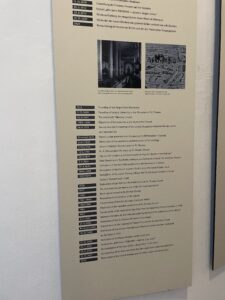
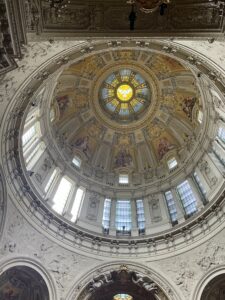
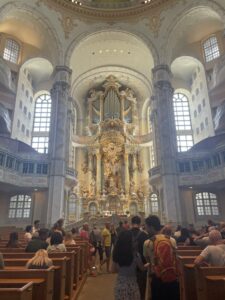
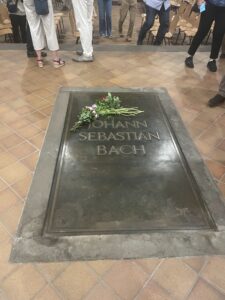
Having the opportunity to scrutinize, analyze, and appreciate the musical and textual choices made by Bach before each concert has enhanced my experience as an audience member astronomically: I have come away with a much better understanding of how to be an engaged listener and an enhanced appreciation for musical interpretation.
Moments that were of particular note to me in the Canata concert were the way in which the words“Weinen, Klagen, Sorgen, Zagen” extended into each other for a little longer than Bach wrote in his score, perhaps to prolong the sense of grief evoked in the listener. I was surprised at the choices made with the words “Angst and Not” – initially more tentative, but, when repeated, more aggressive. I was impressed, later in the same Cantata, at how the singer was able to make the wavering “ei” melisma in “alle Pein”sound so much like great suffering, a feature that can only be realized during live performance. I also enjoyed the duets I could hear between the picollo and the soprano during BWV103, which was more playful than I had expected given the theme of pain and suffering that pervaded the three Cantatas (although, notably, this aria was about healing!).
I was a little surprised by the more dramatic interpretation given of the St. John Passion. For instance, the bass singing the part of Jesus was more expressive than I expected, using his hands and facial expressions to enhance his performance. The tenor who sang the aria following Jesus’ condemnation to death was incredible, although again more dramatic than I expected him to be – I in fact appreciated this break from the more sombre, less expressive mood of the piece. It was also interesting to notice the movements for which the soloists would come out front as opposed to staying with the rest of the chorus (which I thought was possibly linked to Professor Heller’s proposition on the role of time in the St. John Passion, although this was not always the case – at one point, the singer voicing Jesus came out to the front). I was also interested to notice that the theme from the initial soprano aria kept returning in the chorus’ line — perhaps Bach was trying to blur the boundary between what it means to be a good believer versus how easy it was to fall into the trap of condemning Jesus to death.
Finally, it is so cool to be able to attend these performances in the places Bach might have come up with many of his ideas!! It felt particularly awesome that I had been in Weimar the very same day as I attended the “Art of Dying” cantatas alongside Ruth and Vito — BWV161 was initially written and performed there!!
In all, having had the opportunity to go over the music before the concert greatly enhanced my listening experience, and I am looking forward to putting this skill to use in my future concert-going endeavours.
Upon my arrival in Leipzig, I noticed the ‘great man’ everywhere – from the street names, like Karl Liebknecht Straße and Bernhard Göring Straße, to the statues of figures like Leibniz, Bach, and Mendelssohn that towered over me as I walked past. It seemed to me that Bach was being used as a marketing tool: a ‘great man’ who was being used to attract tourists (for an example, see the Bach fest banner at the Hauptbahnhof). Until fairly recently, biography writing similarly struck me as a ‘great man’ venture (as discussed by Marshall, p.12). Despite the fact that I have taken several literature, history, and music classes, where I have been taught that interpretation is quite possibly the furthest thing from what can be described as ‘static,’ I could not fully grasp the idea that biographies evolve. But reading Heller’s “Postlude and Prelude: Bach and the Baroque” and particularly Marshall’s “Young Man Bach: Toward a Twenty-First Century Bach Biography” changed my mind. Both articles brought to the surface considerations that have formerly been left out of Bach studies – Marshall encouraging a psychological interpretation of Bach’s troubled childhood (which perhaps went a little too far) and Heller emphasizing the way in which humour wove its way into Bach’s life and music. The latter was further illuminated by our visit to the Bach archive during which Peter Wollny told us a fascinating anecdote about the letter of recommendation penned by Bach’s daughter! I was particularly fascinated by Heller’s attention to the coffee cantata. I have since listened to several recordings that have shifted my interpretation of humor in music, much in the same way as I have recently come to notice moments of humor in texts I formerly perceived as serious. Biography, I have realized, is not static: in the same way as we continue to interpret and re-interpret music, our understanding of the lives of the ‘greats’ evolves and adapts in different contexts. Walking around Leipzig and considering the way in which Bach is marketed over the past week, I have had time to pay attention to Bach’s shifting legacy. He is no longer imagined as a stern, overpowering figure – at the Bach Archive shop, bags of coffee are being sold with the Bach brand (see below). The very theme of the Bach festival – ‘Transformation’ – gets to the heart of this observation, lending itself to a renewed and evolving understanding of Bach’s life and works. One concert that embodies this is the Queerpassion – I would have loved to have gone to see it, but it unfortunately would likely have overlapped with our concert tonight. It seems fair to say that Bach no longer lives in my imagination as the stern, serious figure who once captured my attention. I look forward to continuing my exploration of biography as I begin reading the book Quartet by Leah Broad, which tells the stories of four overlooked female composers from the nineteenth and twentieth centuries. It is exciting to think that formerly overlooked historical figures are beginning to receive the attention they really deserve – I look forward to learning more about the women including Bach’s wives and daughters, and Christiana Mariana von Ziegler who played important and yet underappreciated roles in his life!
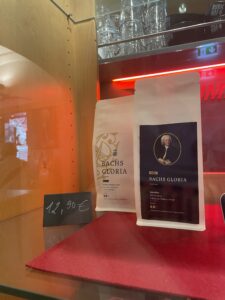
Next on my Leipzig dessert quest is the Leipziger Lerche. This pastry was originally filled with lark – that is, until the saxonian King banned hunting songbirds in 1876! Now, it’s baked with almonds, nuts, and a cherry. Unfortunately, although it has a fascinating history, I wasn’t a huge fan of the pastry itself.
[see: https://en.wikipedia.org/wiki/Leipziger_Lerche]
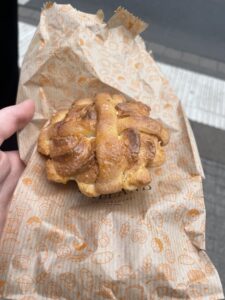
(Side note: I would highly recommend Quarkkeulchen, a Saxonian speciality, which I tried at Barthel’s Hof – delicious!)
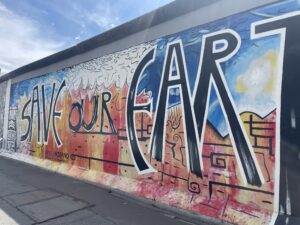
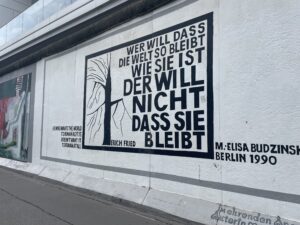
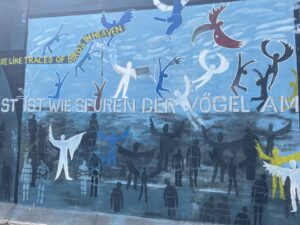
Beautiful organ! And panoramic view of the city!
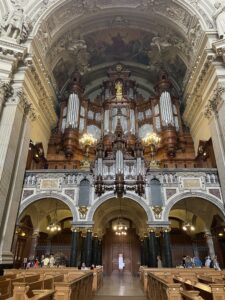
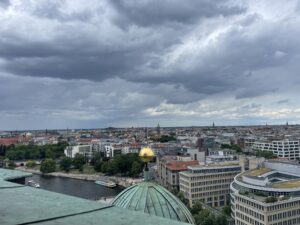
Greetings from Leipzig!
